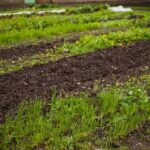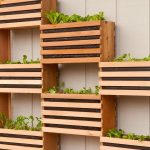Are you looking to add some creativity to your vegetable gardening? This article will explore a variety of innovative container gardening ideas that will not only help you grow your own veggies but also add a unique and aesthetic element to your space. From choosing the right containers to maximizing small spaces and even incorporating edible landscaping, we’ve got you covered with expert advice and best practices.
When it comes to vegetable gardening, creative container gardening ideas can make all the difference. Whether you have limited outdoor space or simply want to add a touch of personality to your garden, thinking outside the traditional garden bed can open up a world of possibilities.
In this article, we’ll delve into the art of container gardening for vegetables and explore how you can use unconventional containers, vertical gardening techniques, and even mix vegetables with flowers for an edible landscape.
Not only will we provide tips on maintaining a thriving vegetable garden in containers, but we’ll also introduce DIY projects for beginners and sustainable ways to reuse and repurpose containers. So if you’re ready to take your vegetable gardening to the next level, keep reading for inspiration and practical advice on successful container gardening.
Choosing the Right Containers for Your Vegetable Garden
When it comes to container gardening for vegetables, choosing the right containers is crucial to the success of your garden. The first step in selecting the perfect containers for your vegetable garden is to consider the size and space available. If you have limited space, opt for smaller containers that can be grouped together or placed on balconies or patios. For larger spaces, you can experiment with a variety of container sizes and shapes.
In addition to size, it’s important to consider the material of the containers. While traditional terracotta pots are a popular choice, there are many other options available. You can consider using wooden crates, metal buckets, or even repurposed items such as old tires or tin cans. Just make sure the containers have proper drainage holes to prevent waterlogging and root rot.
Furthermore, take into account the weight of the containers when filled with soil and plants. If you plan to move your containers around frequently, lightweight plastic or resin pots may be more suitable than heavy ceramic or concrete ones. Additionally, consider the depth of the containers depending on the types of vegetables you plan to grow. Deeper containers are ideal for root vegetables like carrots and radishes, while shallow ones work well for herbs and lettuces.
Lastly, don’t shy away from getting creative with your choice of containers. Upcycling old items into planters not only adds character to your garden but also promotes sustainability.
For example, an old wheelbarrow can be turned into a mobile vegetable garden by adding soil and plants directly into it. By thinking outside the box and considering these factors, you can choose the right containers that will support healthy vegetable growth in your container garden.keyword: vegetable gardening creative container gardening ideas.
Unique and Unconventional Container Gardening Ideas
When it comes to vegetable gardening, thinking outside the traditional garden plot can lead to some truly unique and unconventional container gardening ideas. Whether you have limited space, want to add a decorative touch to your patio, or simply enjoy the challenge of finding creative ways to grow your own food, there are plenty of innovative options to explore. Here are some ideas to inspire your vegetable gardening creative container gardening projects:
- Tiered Shoe Organizer Garden: Utilize a hanging shoe organizer with pockets as a vertical garden for growing herbs, salad greens, and small vegetables. Hang it on a sunny wall or fence for easy access to fresh produce.
- Wheelbarrow Garden: Turn an old wheelbarrow into a mobile vegetable garden by filling it with soil and planting your favorite vegetables. This portable option allows you to move your garden around as needed for optimal sunlight and space usage.
- Mason Jar Herb Garden: Repurpose mason jars by mounting them on a wooden board or hanging them individually in a sunny window. Plant different herbs in each jar for a compact and visually appealing indoor herb garden.
These unique container gardening ideas not only offer practical solutions for growing vegetables in non-traditional spaces but also add an element of creativity and charm to your gardening endeavors. With a little imagination and resourcefulness, there are endless possibilities for creating one-of-a-kind vegetable gardens in containers.
Vertical Vegetable Gardening in Containers
When it comes to creative container gardening ideas, vertical vegetable gardening is a game-changer. Utilizing vertical space not only maximizes the potential of your container garden but also adds an aesthetically pleasing element to your outdoor or indoor space.
Benefits of Vertical Vegetable Gardening
One of the major benefits of vertical vegetable gardening in containers is the ability to grow more plants in a smaller area. This is especially advantageous for those with limited space, such as apartment dwellers or small urban yards. Vertical gardens also make it easier to organize and tend to your plants, as they are all within easy reach.
Choosing the Right Vegetables for Vertical Gardens
Not all vegetables are suitable for vertical gardening, so it’s important to choose the right ones for your containers. Some great options for vertical growing include tomatoes, cucumbers, pole beans, and peas. These vining and climbing plants thrive when given support and can be trained to grow upwards on trellises or stakes within the containers.
DIY Vertical Garden Projects
For those looking for a hands-on approach, there are plenty of creative and sustainable DIY projects for creating vertical vegetable gardens in containers. From repurposing old wooden pallets into planters to constructing tiered hanging gardens using recycled materials, the possibilities are endless. Not only do these projects add a personal touch to your garden, but they also demonstrate environmentally friendly practices through upcycling and reusing existing items.
Incorporating a vertical element into your vegetable garden not only saves space but also opens up opportunities for unique and visually stunning displays of edible plants. Whether you’re embarking on your first container gardening project or looking to expand an already thriving garden, vertical vegetable gardening is an innovative and practical choice that will bring new life to your growing space.
Maximizing Small Spaces With Container Gardening
Living in a small space doesn’t mean you have to give up on the idea of having your own vegetable garden. Container gardening is a perfect solution for homeowners who have limited outdoor space. It allows you to grow your favorite vegetables, herbs, and fruits in pots, containers, or unconventional items like old tires or wooden crates. Below are some creative and practical ideas for maximizing small spaces with container gardening.
1. Hanging Gardens: Utilize vertical space by hanging containers from hooks or installing a wall-mounted trellis. This is a great way to grow vining crops such as tomatoes, cucumbers, and peas without taking up precious ground space.
2. Tiered Planters: Use tiered planters to create layers of greenery and maximize space vertically. You can find tiered planters at gardening stores or create your own using shelves or repurposed materials.
3. Window Boxes: Take advantage of windowsills and railings by planting vegetables in window boxes. Herbs like basil, parsley, and chives thrive in these compact containers, making them ideal for small-space gardening.
By thinking outside the box and getting creative with how you use your available space, you can still enjoy the benefits of vegetable gardening even in a small area. Implementing these unique container gardening ideas will not only allow you to grow fresh produce but also add charm and greenery to your home’s exterior. Remember to consider the needs of each plant when choosing containers and locations for your vegetable garden.
With a little ingenuity and planning, anyone can have a successful vegetable garden no matter how limited their outdoor space may be related to vegetable gardening creative container gardening ideas. ‘_.
Edible Landscaping
When it comes to vegetable gardening, the concept of edible landscaping is a creative and aesthetically pleasing way to grow your own produce. By combining vegetables and flowers in containers, you can add beauty to your garden while also reaping the benefits of homegrown edibles. This approach not only enhances the visual appeal of your garden but also attracts pollinators and beneficial insects, ultimately contributing to a healthier and more vibrant growing environment for your plants.
One of the key elements of successful edible landscaping is choosing the right combination of vegetables and flowers that complement each other in terms of growth habits, water and sunlight requirements, as well as aesthetics. For example, pairing trailing or vining vegetables like cherry tomatoes or cucumbers with tall flowering plants like marigolds or nasturtiums can create a visually appealing display while maximizing space in your containers.
Additionally, including herbs such as basil or lavender can add fragrance and culinary uses to your edible landscape.
In terms of container selection, consider using larger pots or planters that provide enough room for both the vegetables and flowers to thrive. Proper drainage is essential for maintaining a healthy garden, so be sure to choose containers with adequate drainage holes at the bottom. With the right combination of plants and thoughtful container choices, you can create an edible landscape that blends functionality with beauty in your vegetable gardening creative container gardening ideas.
| Edible Landscaping Ideas | Benefits |
|---|---|
| Pairing tall flowering plants with vining vegetables | Provides visual appeal and maximizes space |
| Including herbs like basil or lavender in the mix | Adds fragrance and culinary uses |
| Choosing larger pots with proper drainage | Promotes healthy growth for both vegetables and flowers |
Tips for Maintaining a Thriving Vegetable Garden in Containers
Maintaining a thriving vegetable garden in containers requires special attention and care to ensure the plants have everything they need to grow and produce a bountiful harvest. One of the most important considerations when it comes to container gardening is proper watering.
Since containers can dry out more quickly than traditional garden beds, it’s essential to water your vegetable plants regularly, especially during hot or dry weather. Consider investing in a drip irrigation system or self-watering containers to help maintain consistent moisture levels in your containers.
In addition to proper watering, it’s crucial to regularly feed your container-grown vegetables with a high-quality organic fertilizer. Since container soil can become depleted of nutrients more quickly than garden soil, it’s important to provide your plants with the necessary nutrients for healthy growth and development. Consider using a slow-release fertilizer or making your own compost tea to nourish your vegetable plants throughout the growing season.
Another tip for maintaining a thriving vegetable garden in containers is to monitor for pests and diseases regularly. Container-grown vegetables are not immune to pest infestations or diseases, so it’s essential to keep an eye out for any signs of trouble. Implement integrated pest management strategies such as hand-picking pests off your plants, using natural predators like ladybugs, or utilizing organic pest control methods to keep your container garden healthy.
By following these tips and implementing best practices for maintaining a thriving vegetable garden in containers, you can enjoy a successful growing season with an abundant harvest of fresh, homegrown produce. With some creativity and resourcefulness, you can turn even the smallest outdoor space into a productive and beautiful vegetable garden using container gardening ideas.
DIY Container Gardening Projects for Beginners
Gardening enthusiasts who are just starting out on their vegetable gardening journey can find a lot of joy and satisfaction in creating their own DIY container gardening projects. From small herb gardens to compact tomato planters, there are endless possibilities for new gardeners to get creative with their vegetable gardening endeavors. Here are some beginner-friendly ideas for DIY container gardening projects that will inspire and excite those with green thumbs.
Herb Garden in a Window Box
One simple and practical DIY project for beginner vegetable gardeners is creating an herb garden in a window box. This is a great option for those who have limited outdoor space or live in urban settings where outdoor containers may not be feasible.
Choose a sunny windowsill and fill the window box with nutrient-rich soil, then plant your favorite herbs such as basil, thyme, and rosemary. Not only does it add greenery to your living space, but it also provides convenient access to fresh herbs for cooking.
Repurposed Pallet Planter
For the environmentally conscious beginner gardener, repurposing old pallets into planters is both sustainable and budget-friendly. With just a few basic tools and some creativity, you can transform an ordinary wooden pallet into a vertical planter for growing vegetables such as lettuce, radishes, or even strawberries. Simply stand the pallet upright and secure landscape fabric across the back and bottom of each section before adding soil and planting your chosen crops.
Upcycled Tire Garden
For those looking for a quirky and unconventional DIY container gardening project, upcycling old tires into planters is an interesting option. Tires can be painted in bright colors to add visual interest to your garden space while also preventing them from leaching harmful chemicals into the soil through proper preparation.
Stack layers of tires on top of each other, filling each one with soil and plants like peppers or carrots to create a unique vertical garden that will certainly be a conversation starter.
By tapping into their creativity and resourcefulness, beginners can explore these DIY container gardening projects as a fun way to kickstart their journey into vegetable gardening while enjoying the process of nurturing plants from seedlings to harvest. Whether using repurposed materials or building something entirely new from scratch, these hands-on projects offer invaluable learning experiences that extend beyond just growing vegetables in containers.
Creative and Sustainable Ways to Reuse and Repurpose Containers for Vegetable Gardening
When it comes to creative and sustainable ways to reuse and repurpose containers for vegetable gardening, the possibilities are endless. Not only does this practice help reduce waste by giving new life to old items, but it also adds a unique and charming touch to your garden. One of the most popular ways to repurpose containers for vegetable gardening is by using items such as old tires, wooden crates, or even kitchenware like colanders and teapots.
Innovative gardeners have been known to transform everyday items into functional planters for their vegetable gardens. For example, an old wooden ladder can be repurposed into a vertical garden by adding shelves or attaching small planters to each step. Other unconventional ideas include using rain boots, wheelbarrows, or even a broken birdbath as containers for growing vegetables.
Not only does repurposing containers for vegetable gardening add a creative flair to your garden, but it also promotes sustainability by reducing the amount of waste sent to landfills. By choosing this eco-friendly approach, you can showcase your unique style while contributing to a greener and more environmentally conscious way of gardening.
| Container Option | Description |
|---|---|
| Old Tires | Tires can be stacked and filled with soil for planting various vegetables. |
| Kitchenware | Colanders, teapots, and other kitchen items can be used as whimsical planters. |
| Wooden Ladder | An old ladder can be repurposed into a vertical garden with multiple tiers of planting space. |
| Rain Boots/Wheelbarrows | These items can be filled with soil and used as unique planters for vegetables. |
Expert Advice and Best Practices for Successful Vegetable Gardening in Containers
In conclusion, vegetable gardening in containers offers a world of creative possibilities for gardeners of all levels. From choosing the right containers to unconventional ideas and vertical gardening, there are endless ways to maximize small spaces and create thriving vegetable gardens. By blending vegetables and flowers in edible landscaping, gardeners can also add beauty to their outdoor spaces while reaping the rewards of homegrown produce.
One important piece of advice for successful container gardening is to ensure that your chosen containers have proper drainage to prevent waterlogged soil and root rot. Additionally, using high-quality potting soil and regularly fertilizing your vegetable plants will help them thrive throughout the growing season. It’s also crucial to monitor the moisture levels of your containers, especially during hot summer months, to ensure that your plants receive adequate water.
As you embark on your container gardening journey, don’t be afraid to get creative with DIY projects or find sustainable ways to repurpose containers for your vegetable garden. With the right guidance and best practices, anyone can enjoy the rewards of growing their own fresh produce in unique and innovative ways. Whether you’re a beginner or an experienced gardener, container gardening provides a canvas for endless exploration and experimentation with nurturing nature in smaller spaces.

If you’re looking to get into vegetable gardening, or are just looking for some tips on how to make your current garden better, then you’ve come to the right place! My name is Ethel and I have been gardening for years. In this blog, I’m going to share with you some of my best tips on how to create a successful vegetable garden.





